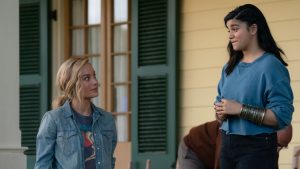
Even if you’ve never read a single X-Men comic book in your life, you probably still know some of the big stories. The Dark Phoenix Saga, in which Jean Grey gets possessed by a world-destroying entity of unspeakable power. Days of Future Past, in which an X-Man from the future comes to the present to prevent the unthinkable. Weapon X, in which Wolverine is transformed into a killing machine.
These stories get told and retold in movies, cartoon shows, and video games, and with good reason. They’re among the best superhero stories ever written. But they’re hardly the only good stories in X-Men history. The team has existed since 1963, and while they didn’t hit their stride until writer Chris Claremont took over in 1974, that still leaves decades worth of complex, complicated issues to unravel.
But it need not be so complicated. If you want to get a bit deeper into Marvel’s merry mutants, but don’t have time or money to read 50 issue storylines, here are the best underrated tales that span only a few issues.
Photo: Marvel Comics
“The Uncanny Threat of…Unus, the Untouchable” (X-Men #8, 1965)
No one counts the first X-Men comics among the best work of creators Stan Lee or Jack Kirby, but that doesn’t mean they’re without their charms. After all Stan and Jack launched the Marvel Universe, and even half-speed puts them ahead of most of their contemporaries. X-Men #8 introduces a classic Silver Age character, Unus the Untouchable.
Beyond his typical alliterative name, Unus the Untouchable also has the type of superpower that could only come from Marvel’s Silver Age. Unus cannot be touched. Every time someone tries, they bounce right off of him. Silly as the power might be, it gives Jack Kirby an excuse to draft some wonderfully kinetic scenes, especially when Beast goes up against Unus. “The Uncanny Threat of… Unus, the Untouchable” is one of the rare X-Men comics that showcases the best of King Kirby.
Photo: Marvel Comics
“The ‘X’-Sanction” (Uncanny X-Men #110, 1978)
When Chris Claremont took over X-Men in 1974, he revitalized the property with complex soap opera style plotting and more legible civil rights metaphors. However, he also cut that dense storytelling with low-stakes moments of the X-Men just hanging around. Claremont established that model in Uncanny X-Men #110, which begins with the X-Men playing a game of baseball.
To be clear, the baseball game only lasts for a few pages before the D-list supervillain Warhawk sneaks into the X-Mansion to trap the team in the Danger Room. And even then, the game itself is pretty raucous: Wolverine pops his claws through his catcher’s mitt and Colossus transforms to steel to steal a base. Guest artist Tony DeZuniga doesn’t have quite the same fluid punch as regular artist at the time Dave Cockrum, but both the baseball and Danger Room scenes prove that, for the X-Men, most accidents happen at home.
Photo: Marvel Comics
“Kitty’s Fairy Tale” (Uncanny X-Men 153, 1982)
It might not be totally accurate to call “Kitty’s Fairy Tale” underrated, as the story is a favorite from the early Claremont era, one frequently referenced in later comics. However, it still deserves attention from anyone looking for a great standalone comic, as it captures the vast possibilities offered by the X-Men.
Written by Claremont and penciled by Cockrum, “Kitty’s Fairy Tale” finds teenage new recruit Kitty Pryde trying to put down Colossus’s kid sister Illyana (then still a little girl and not yet the sexy demon lady Magik). To help Illyana sleep, Kitty tells a fairy tale about a pirate called Kitty and her first mate Colossus going on a quest. Along the way, they encounter Bamf (Nightcrawler), the Fiend With No Name (Wolverine), and the Noble Prince (Cyclops). Kitty’s tale charms on its own, but it also shows how the character makes sense of the X-Men, who she’s still getting to know at that point.
Photo: Marvel Comics
“He’ll Never Make Me Cry…” (Uncanny X-Men #183, 1983)
To be honest, a lot of “He’ll Never Make Me Cry…” looks bad from a modern perspective. The story deals with the fallout of the Secret Wars event, in which Colossus falls in love with an alien lady, despite dating Kitty Pryde back on Earth. But Colossus is a grown man and Kitty a young teen, something strangely common in ’80s comics (I love you Hal Jordan, but…) and obviously not okay now. Furthermore, there’s a paternalistic vibe to Wolverine and Nightcrawler’s response to Colossus dumping Kitty, as they take him to a local bar to read him the riot act.
Still, if one can put those elements aside, “He’ll Never Make Me Cry…” is an utter blast. While Wolvie and Nightcrawler plan to give Colossus a “man up” talk, they get a better idea when they see Cain Marko aka Juggernaut minding his own business at the bar. But when Colossus accidentally spills beer on Juggs, Wolverine decides the best lesson is a beatdown from the unstoppable foe. The result is a delightful beatdown that ultimately makes readers love the characters all the more.
Photo: Marvel Comics
“Slumber Party” (The New Mutants #21, 1984)
The Demon Bear Saga might last just three issues, but it has more horror and intrigue than nearly any other story arc of the original New Mutants comic. So after that tale, in which an evil psychic entity from Mirage’s past threatens her and the other young students at Xavier’s school, it makes sense that the team would need a breather. So the girls of the New Mutants blow off steam in the best way they know how, inviting friends from the Salem Center over to the mansion for slumber party.
A lot of “Slumber Party” lets the New Mutants kids be kids, trading jokes about pop stars and teasing one another about crushes. Although he writes in his usual exaggerated style, Claremont has a clear handle on the character voices, helping them feel like well-rounded figures. However, the pencils come from Bill Sienkiewicz, whose manic line work better suits a horror story. And sure enough, “Slumber Party” becomes just that when a mysterious alien begins stalking the teens.
Photo: Marvel Comics
“Ladies’ Night” (Uncanny X-Men #244, 1989)
Uncanny X-Men #244 is the first appearance of Jubilation Lee, a teen with the ability to shoot fireworks from her hands, who will become one of the most popular characters on the team. Does that mean the X-Men leave the mansion and go to the mall, you ask? Of course they do, I answer. Where else will mall babes eat chili fries?
“Ladies’ Night” takes place shortly after Fall of the Mutants, a pseudo-crossover in which everything went bad for all X-characters. In the case of the X-Men, they appeared to die on live television and were hiding out in the Australian outback, getting around via an Aboriginal mutant teleport called Gateway. If that sounds like a lot, then rest assured, “Ladies’ Night” is not. Realizing that the team needs to blow off steam, Storm has Gateway send her, Psylocke, Dazzler, and Rogue to an L.A. mall, where they shop, flirt, and battle a team of doofus mutant hunters called The M Squad.
Photo: Marvel Comics
“Resurrection and the Flesh” (X-Men #4, 1991)
No, “Resurrection and the Flesh” certainly does not sound like the type of fun, standalone story that has populated this list so far. And, in many ways, it isn’t. Not only does it debut the super-edgy bad guy Omega Red, but “Resurrection and the Flesh” includes a jumble of storylines involving Banshee and Moira MacTaggert having a spat, Shinobi Shaw leading a hip version of the Hellfire Club called the Upstarts, and other regular soap opera stuff.
But weaving throughout these larger storylines is a two-on-two basketball game, with Wolverine and Jubilee going up against Gambit and Rogue. Does Wolverine get mad and pop his claws? Of course! Does Rogue freak out when sweaty, shirtless Gambit tries to sneak a kiss? You know it! The basketball storyline in X-Men #4 is pure ’90s goodness, all delivered courtesy of Jim Lee’s overly-crosshatched art!
Photo: Marvel Comics
“X-Aminations” (X-Factor #87, 1993)
As fun as comics like X-Men #4 were, the ’90s weren’t exactly the high point of X-Men comics. With artists such as Lee and Rob Liefeld calling the shots, writers like Claremont and Louise Simonson were after thoughts at best. Which is why the cool kids knew that the best X-book of the early ’90s wasn’t either of the X-Men titles and certainly wasn’t X-Force. It was X-Factor, written by the brilliant and hilarious Peter David.
X-Factor #87 is the standout of David’s run, despite the incongruously flashy pencils by artist Joe Quesada. Set immediately after the big X-Cutioner’s Song event, “X-Aminations” consists of nothing but the various members in a therapy session with Leonard Samson. That might sound dry, but it shows the depth that David could bring to the characters. In just a few pages, Quicksilver explains the connection between his superspeed and his arrogance, Havok reveals the difficulty of leading a team in the shadow of his brother Cyclops, and more. The Polaris scenes clang a bit today, and the issue’s cliffhanger might confuse readers looking for a single issue read, but otherwise “X-Aminations” remains a classic.
Photo: Marvel Comics
“Silence: Psychic Rescue In Progress” (New X-Men #121, 2001)
The 1990s began with the X-Men at a high point, but years of letting flashy artists run the show began to wear as the decade went on. By the end of the new century, X-Men comics were shallow, self-indulged, and dull. Scottish writer Grant Morrison came in to fix that problem by making mutants hip and weird again. Also by putting the team in black leather, which seemed like a good idea at the time.
Morrison always does best with their fellow Scot Frank Quitely, who isn’t everyone’s favorite. But an issue like New X-Men #121 shows why Quitely is one of the best of the business. An almost entirely silent issue, “Silence: Psychic Rescue In Progress” involves psychics Jean Grey and Emma Frost exploring the confines of Professor X’s mind. The issue leads to a bigger arc involving Xavier’s evil twin Cassandra Nova, but it also works as a stand-alone glimpse of the wonders and terrors inside the good Professor’s brain.
Photo: Marvel Comics
“X-Statix: The Movie” (X-Statix #9, 2003)
Morrison wasn’t the only person pushing the boundaries of the X-Men in the early 2000s. Vertigo Comics mainstay Peter Milligan and indie great Mike Allred teamed to make X-Statix, a team of vain, young mutants who become hyper-violent reality tv stars. Hilariously, X-Statix first launched as X-Force and the first issue of the series saw almost every member of the team die in horrifying ways.
Those two facts speak to the level of irreverence that Milligan and Allred brought to the project, but it’s X-Statix #9 that best captures their approach. As the title suggests, “X-Statix: The Movie” features a movie made about the team. The issue’s filming plot carries on the critique of crass media that ran throughout the series. However, the reactions by the characters reveal a depth not always obvious in the book’s over-the-top tone, making for a complex and compelling story.
Photo: Marvel Comics
X-Men: Season One (2011)
To modern readers, especially those not immersed in Marvel Comics in general, the original five X-Men might seem like dull precursors to the good stuff that came later on. Sure, Iceman and Angel have their fans, but those guys don’t have the same draw as Wolverine. And while the initial stories about the Original Five aren’t terribly impressive, later visions of the early X-Men have made that team much more compelling.
The digest-sized one-shot X-Men: Season One comes from Dennis Hopeless and Jamie McKelvie, the perfect duo to give a modern spin on the ’60s characters. New student Jean Grey serves as the narrator, capturing the discomfort of being thrust into an unfamiliar world and the excitement of becoming an honest-to-goodness superhero. X-Men: Season One manages to be as wholesome as the 60s comics without ever getting hokey. Even better, it shows that the Original Five don’t need a short, hairy Canadian to be cool.
Photo: Marvel Comics
Cyclops #1 (2015)
If you’ve made it this far into the list, then you know that X-Men comics can get convoluted. They got even more messy in the mid-2010s, when Cyclops became a radical mutant liberation fighter. Worried that his old friend has become a terrorist, Beast makes the absurd decision to bring the original five X-Men, just days after Jean came to the school, into the present. So yes, for several years, there were two versions of Cyclops, Beast, Angel, and Iceman running around (Jean was dead. Again.).
Opinions vary on the quality of those stories, but no one can help but love the Cyclops series that came out of it. In the mainline continuity, Scott Summers thought his parents died in a plane crash, and did not learn that his father survived as the sexy space pirate Corsair until he was an adult. Written by Greg Rucka and penciled by Russell Dauterman, Cyclops gives teen Scott Summers a chance to make up for lost time and reconnect with dad. Of course, it doesn’t go as easily as he hopes, but the first issue of the series is a feel-good single issue.
Photo: Marvel Comics
“The End of the Beginning” (Wolverine: Weapon X #16, 2016)
“My best friend is dead,” begins Wolverine: Weapon X #16, written by Jason Aaron and penciled by Davide Gianfelice. The issue takes place shortly after Nightcrawler sacrificed himself, leaving his closest pal Wolverine to ponder the meaning of life. Nightcrawler and Wolverine have one of the best friendships in comics, mostly because of the vast differences between them. The gruff Wolverine tends to be nihilistic, while the devout and charming Nightcrawler keeps the faith.
“The End of the Beginning” finds Wolverine carrying out Nighcrawler’s last request. Ever the jokester, even in death, Nightcrawler charges his best friend with transporting a priceless piano to church at the top of a Venezuelan mountain. What follows is a combination of pathos and humor, as Wolverine recalls everything he loved and hated about his friend. Even if Nightcrawler’s death turned out to be more of a passing phase than eternal rest, the issue still works as a fitting tribute to old pals.
Photo: Marvel Comics
“Lifedeath” (X-Men #7, 2019)
Of course, Nightcrawler comes back to life. Because as much as the X-Men die, they also get resurrected on a regular basis too. So when writer Jonathan Hickman came onboard with a massive relaunch of the X-Men line, in which the mutants form a sovereign nation on the island Krakoa, he also made the mutants’ many returns into a feature instead of a bug. On Krakoa, all mutants can get resurrected in new bodies, which is particularly good news for the thousands of former mutants who lost their powers when the Scarlet Witch wished them away.
“Lifedeath,” a title that pays tribute to a classic set of Storm stories, shows how the de-powered mutants get resurrected with their abilities intact, and it isn’t pretty. The hulking Apocalypse stands in an arena, towering over the depowered wraith Melody Guthrie. As he monologues about worthiness and evolution, Apocalypse battles the tiny Melody, easily mangling her body in the process. Of course, it all leads to her resurrection as the mutant Aero, but the issue also acknowledges the upsetting nature of the ritual.
Photo: Marvel Comics
“Inside the Vault/Out of the Vault” (X-Men #18 – 19, 2021)
As the above description suggests, Hickman gets a lot of credit for his big ideas, and with good reason. But he also deserves credit for his excellent storytelling chops. “Into the Vault” does play like an overwhelming Hickman tale, as it follows a trio of young mutants — Laura Kinney aka Wolverine, Darwin, and Synch — into a vault where time passes differently, in order to investigate the threat posed by the godlike figures inside.
But the emotional core of the two stories comes from the relationship between Wolverine and Synch, who live decades as survivors and freedom fighters inside of the vault. During those years, the two form a bond that becomes deep love and companionship. And yet, when they die at the end of their battle, they get resurrected as teens again on Krakoa, with only a few days past. Worse, Wolverine has no memory of her relationship with Synch. Hickman and artist Mahmud Asrar nail the over-the-top action of the story’s sci-fi premise, but they also nail the smaller elements, including the basic tragedy of an epic romance that no longer exists.
The post The Most Underrated X-Men Stories of All Time appeared first on Den of Geek.







